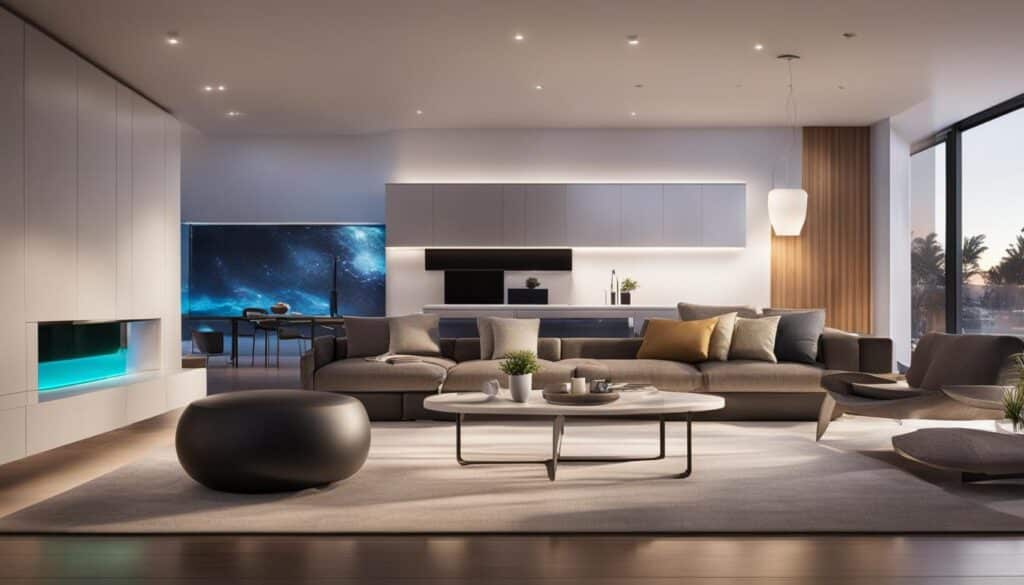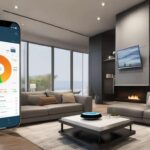Smart home technology has transformed our living spaces, offering unparalleled convenience and efficiency. As technology continues to advance at a rapid pace, there are several exciting upcoming trends in home automation that are set to redefine the way we interact with our homes. From integrated smart home systems to cutting-edge artificial intelligence, these trends promise a future of futuristic home automation that is both functional and awe-inspiring.
Table of Contents
Key Takeaways:
- Integration of smart home technology allows for seamless communication and operation of connected devices.
- Artificial intelligence and the Internet of Things (IoT) are driving the advancement of smart home technology, introducing voice assistants and smarter living experiences.
- Touchless technology is gaining popularity, promoting hygiene and convenience in smart homes.
- Smart thermostats and health-focused tech provide energy efficiency and prioritize overall well-being.
- The future of home automation promises personalized and efficient homes that cater to our needs and preferences.
Integration of Smart Home Technology
One of the biggest trends in home automation is the increasing integration of smart home technology. Smart home devices are becoming more interconnected, allowing for seamless communication and operation. This integration enhances convenience and ease of use, providing homeowners with a more streamlined and efficient living experience.
One example of this integration is the use of Google Home speakers. These smart speakers can be grouped and synchronized to function together, enabling users to control various aspects of their connected smart home devices using voice commands. Whether it’s adjusting the temperature, dimming the lights, or playing music, Google Home speakers offer a hands-free, intuitive way of managing the smart home ecosystem.

Additionally, the Philips Hue lighting system exemplifies the integration of smart home technology. With the Philips Hue system, users can control and personalize the lighting in their entire home or individual rooms using their smartphones or voice commands. This allows for enhanced ambiance, energy savings, and even automation based on preset schedules or triggers.
“The integration of smart home technology enables a seamless connection between various devices, creating a truly connected home ecosystem. This level of integration enhances convenience and ease of use, ultimately making our lives easier and more comfortable.” – Smart Home Magazine
By providing a unified platform for communication and control, the integration of smart home technology simplifies the management and operation of connected devices. Whether it’s controlling the lighting, adjusting the temperature, or managing security systems, the seamless interplay between different devices ensures a cohesive and efficient smart home experience.
The Benefits of Integration:
- Convenience: With the integration of smart home technology, homeowners can easily control and manage multiple devices using a single interface, enhancing convenience and eliminating the need for multiple apps or control panels.
- Energy Efficiency: Integration allows for automated routines and schedules, enabling energy-saving practices such as turning off lights when a room is unoccupied or adjusting the thermostat based on occupancy.
- Personalization: The integration of smart home devices allows for personalized settings and preferences. Users can customize lighting, temperature, and other parameters to create the perfect ambiance and comfort levels for different occasions.
- Seamless Communication: With integrated smart home technology, devices can communicate with each other, facilitating automation and synchronization for enhanced functionality and ease of use.
The integration of smart home technology represents a significant advancement in home automation, enabling homeowners to create a connected ecosystem that enhances their comfort, convenience, and energy efficiency. As more devices become interconnected, the possibilities for seamless communication and operation within the smart home continue to expand.
Artificial Intelligence and Internet of Things (IoT)
Artificial intelligence (AI) plays a significant role in the advancement of smart home technology. With voice assistants like Amazon Alexa and Siri, AI brings a new level of convenience and automation to our homes. These intelligent systems utilize AI algorithms to understand our commands and provide relevant responses, creating seamless interactions between users and their smart devices.
Additionally, the Internet of Things (IoT) has expanded into the realm of smart homes, revolutionizing the way we interact with our kitchens and bathrooms. IoT technology connects various devices and appliances, enabling them to communicate and collaborate effortlessly. In the smart kitchen, for example, IoT-powered appliances can communicate with each other, optimizing cooking processes, and ensuring energy efficiency. In the smart bathroom, IoT devices can automate tasks like adjusting water temperature, conserving water usage, and even analyzing health-related data.
This integration of AI and IoT in smart homes enhances living experiences by providing personalized and efficient solutions. From controlling lighting and temperature to monitoring energy consumption, these technologies empower homeowners to create smarter and more sustainable living spaces.
Examples of AI and IoT in Smart Homes:
- Voice assistants like Amazon Alexa and Siri, enhancing home automation through voice commands.
- Smart kitchen appliances communicating with each other for efficient cooking and energy management.
- Bathroom devices analyzing health-related data, providing insights into personal well-being.
- Smart home systems that learn and adapt to users’ preferences, creating personalized living spaces.
Benefits of AI and IoT in Smart Homes:
- Enhanced convenience: Voice-controlled devices and interconnected systems make daily tasks easier and more efficient.
- Improved energy efficiency: AI algorithms and IoT technology optimize energy consumption, reducing utility bills and environmental impact.
- Personalization: Smart home systems learn users’ preferences and adapt to their routines, providing personalized experiences.
- Health monitoring: IoT devices in the bathroom can collect and analyze health-related data, offering insights into users’ well-being.

Touchless Technology in Smart Homes
Touchless technology is revolutionizing the way we interact with our smart homes. With the ongoing COVID-19 pandemic, the demand for touchless solutions has skyrocketed, leading to the rapid development of innovative touchless tech and devices. These advancements not only promote hygiene and safety but also enhance convenience and control within our living spaces.
Touchless Doorbells for Enhanced Security
One notable application of touchless tech in smart homes is the touchless doorbell. Gone are the days of pressing a physical button or ringing a doorbell. Today, touchless doorbells use motion sensors and facial recognition technology to detect the presence of a person and initiate an alert or notification. This not only minimizes physical contact but also adds an extra layer of security to our homes.
Mobile App Control for Seamless Operation
Another exciting development in touchless technology for smart homes is mobile app control. With a simple tap on our smartphones, we can now control various smart home devices without the need to touch physical switches or interfaces. From adjusting the thermostat to turning on the lights or even managing security systems, mobile app control offers unparalleled convenience and flexibility.
“The integration of touchless technology in smart homes brings a new level of convenience and hygiene to our daily lives. It’s fascinating to see how simple gestures, like waving a hand or using a mobile app, can now command our smart devices and create a seamless living experience.”
– Smart Home Enthusiast
Enhancing Hygiene and Convenience
Touchless technology in smart homes not only mitigates the spread of germs but also promotes a more hygienic and convenient living environment. By reducing physical touchpoints, it minimizes the risk of contamination and helps us maintain a cleaner home. Additionally, the ease of mobile app control ensures that we can manage our smart devices effortlessly, making daily routines more efficient and enjoyable.
As touchless technology continues to evolve, we can expect even more exciting developments in the smart home space. From touchless faucets to voice-activated appliances, the possibilities are endless. The future of smart homes is touchless, offering us a safer, more connected, and personalized living experience.
Smart Thermostats and Health Tech
In the world of smart home technology, smart thermostats have emerged as a game-changer. These devices offer a seamless and convenient way to control the temperature of your home, while also saving energy and reducing utility bills. Smart thermostats can be easily customized to suit individual preferences and routines, ensuring maximum comfort and efficiency.
But the benefits of smart thermostats go beyond just energy efficiency. As the focus on health and well-being grows, there is a rising trend of health-focused smart home tech.
Smart water filtration systems are becoming increasingly popular, offering advanced features that go beyond simply delivering clean water. These systems can analyze water quality, remove impurities, and provide real-time data on water usage. With smart water filtration systems, homeowners can ensure they are consuming the highest quality water, promoting overall health and wellness.
Advanced smart toilets are another aspect of health-focused smart home tech that is gaining prominence. These toilets come equipped with innovative features like waste analysis and skin inspection to provide valuable insights into users’ health. With the ability to detect potential health issues early on, smart toilets contribute to proactive wellness management and personalized healthcare.
The Future of Eco-Friendly Home Automation
As the demand for sustainable living increases, eco-friendly home automation solutions are becoming an integral part of modern households. With the ability to conserve energy, reduce carbon footprints, and optimize resource usage, these technologies offer a greener approach to home management.
Smart thermostats play a crucial role in eco-friendly home automation by intelligently regulating temperature settings, adapting to occupancy patterns, and optimizing energy consumption. By implementing smart thermostats, homeowners can significantly reduce their environmental impact and contribute to a healthier planet.
| Benefits of Smart Thermostats | Health-Focused Smart Home Tech |
|---|---|
|
|
Conclusion
The future of home automation is bright with endless possibilities. The integration of smart home technology, advancements in artificial intelligence (AI) and the Internet of Things (IoT), touchless technology, smart thermostats, and health-focused innovations are revolutionizing the way we live in our homes.
As these trends continue to evolve, our homes will become even smarter, more efficient, and tailored to our unique needs and preferences. The year 2024 holds immense promise for the smart home industry, with new and innovative technologies set to further enhance our living experiences.
Whether it’s the convenience of interconnected smart home devices, the power of voice-assisted AI, or the health benefits offered by intuitive home automation systems, our homes are becoming truly intelligent and responsive spaces.
Keep an eye out for the latest developments and trends in home automation as we continue to embrace the future of smart homes, creating a world where our homes anticipate our every need and provide unparalleled comfort and convenience.
FAQ
What are some upcoming trends in home automation?
Some upcoming trends in home automation include the integration of smart home technology, advancements in artificial intelligence (AI) and the Internet of Things (IoT), touchless technology, and the rise of health-focused smart home innovations.
How does the integration of smart home technology work?
The integration of smart home technology allows for seamless communication and operation between connected smart home devices. For example, Google Home speakers can be grouped to function together, and the Philips Hue lighting system can control the lights in the entire home.
What role does artificial intelligence play in smart home technology?
Artificial intelligence (AI) plays a significant role in smart home technology by enabling voice assistants like Amazon Alexa and Siri to understand commands and provide relevant responses. Additionally, AI-driven IoT devices are expanding in the smart kitchen and bathroom, enhancing efficiency and convenience.
How does touchless technology benefit smart homes?
Touchless technology, such as touchless doorbells and mobile app control for smart home devices, minimizes physical contact and potential germ spread. This trend promotes hygiene and convenience in the home environment, particularly in light of the COVID-19 pandemic.
What are the advantages of smart thermostats?
Smart thermostats offer ease of use and energy-saving capabilities. They can be customized to individual preferences and routines, leading to reduced utility bills. Additionally, there is a growing focus on health in smart home tech, with innovations such as smart water filtration systems and advanced smart toilets that offer insights into users’ well-being.
What does the future hold for home automation?
The future of home automation is filled with exciting possibilities. With the integration of smart home technology, advancements in AI and IoT, touchless tech, smart thermostats, health-focused innovations, and the growing popularity of at-home exercise and home offices, our homes will become smarter, more efficient, and more personalized to our needs and preferences.


